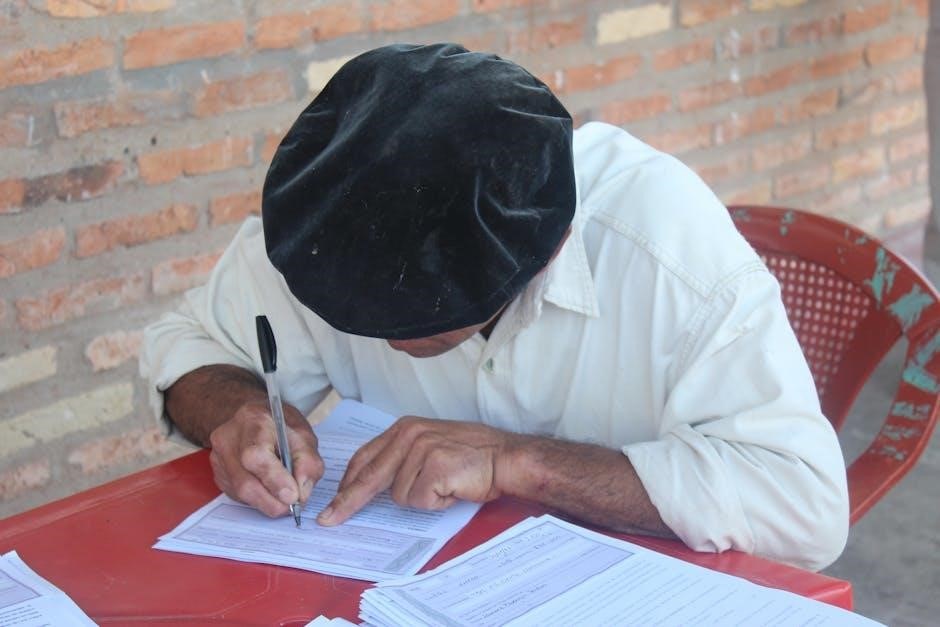Manual verification is a process where humans validate data accuracy, ensuring authenticity and compliance. It is crucial for security, fraud prevention, and maintaining trust across various industries.

1.1 Definition and Purpose
Manual verification is a systematic process where individuals manually check and validate data, documents, or information to ensure accuracy and authenticity. Its primary purpose is to confirm the legitimacy of details, prevent fraud, and maintain compliance with regulations. Across industries, manual verification is essential for ensuring trust and reliability in transactions, applications, and identity checks. It involves human intervention to cross-verify records, documents, or user credentials, addressing discrepancies and ensuring adherence to standards. This method is particularly vital in finance, healthcare, and social media, where accuracy and security are paramount.
1.2 Importance Across Industries
Manual verification plays a critical role across various industries, ensuring accuracy, compliance, and security. In finance, it prevents fraud and ensures reliable credit checks. Healthcare relies on it for patient data accuracy, while real estate uses it to validate property transactions. Education institutions depend on manual verification for enrollment processes. This method builds trust, reduces errors, and ensures adherence to regulations. Its importance spans industries, making it a cornerstone of operational integrity and customer confidence, despite its labor-intensive nature.

Manual Verification in Finance
Manual verification is essential in finance for ensuring accuracy and preventing fraud. It involves thorough checks in credit applications, loan processing, and income validation, maintaining trust and security.
2.1 Credit Checks and Loan Applications
Manual verification plays a critical role in credit checks and loan applications, ensuring the accuracy of applicant data. When an applicant’s information doesn’t match records, manual verification is required. This process involves checking credit history, income, and employment details. Lenders manually review documents to verify identity and financial stability, reducing fraud risks. The process is time-consuming but essential for making informed decisions. It ensures compliance with financial regulations and protects both lenders and borrowers from potential discrepancies. Manual verification in this context is a silent killer of commissions, as delays can impact deal closures and borrower satisfaction.
2.2 Income Verification Processes
Manual income verification involves reviewing financial documents to confirm an applicant’s earnings. This process is essential for loan approvals and credit assessments. When automated systems flag discrepancies, manual checks are required. Bank statements, pay stubs, and tax returns are commonly verified. Manual verification ensures accuracy but can delay processing. It is a critical step in reducing fraud and ensuring compliance with financial regulations. However, it remains a time-consuming process that can hinder efficiency, especially in industries where quick decisions are crucial. Automating this process could significantly improve turnaround times while maintaining security.
Social Media and Online Platforms
Manual verification is crucial for social media platforms like Twitter, where user authenticity is verified through processes like color-coded schemes. This ensures trust and security online.
3.1 Twitter’s User Verification Process
Twitter’s user verification process involves manual checks to ensure account authenticity. Elon Musk introduced a color-coded scheme, where users subscribe to Twitter Blue for verification. This process, though manual, aims to reduce fake accounts and enhance trust. However, it strains the workforce, as each verification requires human oversight. Despite challenges, this method ensures credibility, making it vital for maintaining platform integrity and user confidence in social interactions and information sharing.
3.2 Online Identity Verification Methods
Online identity verification methods often require manual checks to ensure authenticity. These include document reviews, ID checks, and two-factor authentication. Platforms like Twitter use color-coded schemes, while others employ AI-driven tools. Manual verification ensures accuracy but can be time-consuming. Industries rely on these methods to prevent fraud and maintain compliance. Despite advancements, human oversight remains crucial for verifying sensitive information, balancing security with efficiency in digital transactions and user authentication processes.

Document Verification Processes

Document verification involves manual checks to confirm authenticity, ensuring data matches records. It requires specific documents like IDs and bank statements, balancing security with efficiency.
4.1 Steps Involved in Manual Verification
Manual verification involves several structured steps to ensure accuracy. First, documents like IDs and bank statements are submitted for review. Next, data is cross-referenced with official records to confirm authenticity. Verification teams then validate each detail manually, checking for discrepancies. Once verified, the status is updated in the system. This process ensures compliance and security, though it can be time-consuming. Each step is critical to maintaining trust and preventing fraud, making manual verification a reliable method despite its inefficiencies compared to automated solutions.
4.2 Necessary Documents for Verification
Manual verification requires specific documents to confirm authenticity. These include government-issued IDs, bank statements, pay stubs, and utility bills. For financial processes, credit reports and loan applications are essential. In social media, identification documents like passports or driver’s licenses are needed. For property transactions, title deeds and property agreements are required. Each document must be up-to-date and legible to ensure accurate verification. These records help verify identity, income, and ownership, making them critical for manual verification processes across industries.

Challenges and Limitations
Manual verification is time-consuming, prone to human error, and vulnerable to fraud. It requires extensive resources, making it less efficient compared to automated systems.
5.1 Inefficiencies in Manual Processes
Manual verification is often time-consuming and prone to human error, leading to delays in processing applications and transactions. The lack of automation in these processes results in increased operational costs and reduced efficiency. For instance, in finance, manual income verification can slow down loan approvals, impacting customer satisfaction. Similarly, in social media, manual processes like Twitter’s color-coded verification scheme strain resources. These inefficiencies highlight the need for streamlined systems to enhance accuracy and speed, ultimately improving overall productivity and user experience across industries.
5.2 Security Risks and Fraud Prevention
Manual verification processes, while essential for accuracy, often introduce security risks due to human oversight. Sensitive data handled manually can be vulnerable to unauthorized access or misuse. In finance, manual document checks may expose personal information, increasing fraud potential. Similarly, Twitter’s color-coded verification scheme, being manual, raises concerns about potential security breaches. These risks underscore the need for robust safeguards and training to mitigate threats while maintaining the integrity of verification processes across industries.

Industries Relying on Manual Verification
Finance, real estate, healthcare, and education heavily rely on manual verification for accuracy and compliance, ensuring secure transactions, patient data integrity, and proper enrollment processes.
6.1 Real Estate and Property Transactions
In real estate, manual verification ensures property ownership authenticity and transaction legitimacy. It involves checking property deeds, titles, and legal documents to prevent fraud and disputes. This process is critical for secure transactions, as errors can lead to financial losses. Real estate agents and legal experts manually verify documents to confirm seller authority and property details. Additionally, manual verification helps in identifying any encumbrances or liens on the property, ensuring a smooth transfer of ownership. This step is indispensable for maintaining trust and integrity in real estate dealings.
6.2 Healthcare and Patient Data

Manual verification in healthcare ensures patient data accuracy and compliance with regulations. It involves reviewing medical records, prescriptions, and test results to prevent errors. Healthcare professionals manually verify patient information to confirm identities and treatment plans, reducing risks of misdiagnosis or incorrect treatments. This process is critical for maintaining patient safety and trust. Manual verification also helps comply with privacy laws like HIPAA, ensuring sensitive data is handled securely. By manually cross-checking details, healthcare providers can avoid discrepancies and deliver reliable care, making it a cornerstone of patient data management.
6.3 Education and Enrollment Processes
Manual verification plays a vital role in education, ensuring the authenticity of student documents during enrollment. Institutions manually check transcripts, diplomas, and identification to prevent fraud and ensure compliance with admission criteria. This process helps maintain academic integrity and fairness. Verification also involves cross-referencing data to confirm eligibility for scholarships or special programs. While manual verification can be time-consuming, it ensures accuracy and prevents errors. It is a critical step in upholding educational standards and providing equal opportunities for all applicants.

Case Studies and Examples
Examples include Twitter’s color-coded verification and Jamshedpur Police’s online hotel guest verification, showcasing manual verification’s role in enhancing security and efficiency across industries.
7.1 Jamshedpur Police Initiative
The Jamshedpur Police launched an online hotel guest verification facility to streamline the manual verification process. This initiative aims to reduce delays and enhance security by digitizing guest verification, ensuring compliance with legal requirements. It replaces traditional paperwork with an efficient digital system, benefiting both hotels and law enforcement. This effort highlights the importance of manual verification in maintaining public safety while embracing technological advancements to improve accuracy and speed.
7.2 Twitter’s Color-Coded Verification Scheme
Twitter introduced a color-coded verification scheme under Elon Musk, aiming to enhance account authenticity. This manual process assigns different colors to accounts based on verification status, ensuring transparency. However, the reliance on manual verification has strained Twitter’s reduced workforce. Despite challenges, this initiative underscores the platform’s commitment to combating impersonation and improving trust. The scheme reflects the ongoing evolution of verification methods, balancing security with user experience in a rapidly changing digital landscape.
Future of Manual Verification
The future of manual verification lies in automation and AI integration, enhancing efficiency and reducing human error, while maintaining security and compliance in digital processes.
8.1 Automation and AI Integration
Automation and AI are transforming manual verification by enhancing speed and accuracy. AI-driven tools analyze data patterns, reducing human error and streamlining processes. Machine learning algorithms improve document scanning and identity checks, enabling real-time verification. Automated systems handle repetitive tasks, freeing staff for complex cases. Integration of AI in verification ensures compliance with regulations while minimizing fraud risks. This shift is particularly beneficial in finance and healthcare, where precision is critical. As technology advances, manual verification will become faster, more reliable, and scalable across industries.
8.2 Emerging Trends in Verification Technology
Emerging trends in verification technology include AI-driven identity checks, blockchain for secure data sharing, and real-time document analysis. Automated systems now process bank statements and IDs faster, reducing manual effort. Biometric authentication and facial recognition are gaining traction, enhancing security. These innovations improve accuracy, reduce fraud, and ensure compliance. As technology evolves, verification processes become more efficient, enabling businesses to adapt to growing demands. The integration of these tools is reshaping industries, making manual verification more reliable and scalable for the future.

Best Practices for Implementation
Implementing manual verification effectively requires clear guidelines, trained personnel, and regular audits to ensure accuracy and compliance with industry standards.
9.1 Optimizing Manual Processes
Optimizing manual verification involves streamlining steps, reducing redundancy, and enhancing accuracy. Standardizing procedures ensures consistency, while training staff improves efficiency. Implementing checklists and clear guidelines minimizes errors. Leveraging basic tools, like document templates, can also accelerate processes without full automation. Regular reviews of workflows help identify bottlenecks, allowing for continuous improvement. By focusing on these strategies, organizations can enhance the effectiveness of manual verification while maintaining compliance and reducing operational delays.
9.2 Integrating Automation Tools
Integrating automation tools into manual verification processes enhances efficiency and accuracy. Automated systems can quickly validate data, such as identity documents or bank statements, reducing human error. AI-driven platforms, like Veriff, streamline verification by cross-referencing information in real-time. Automation also accelerates tasks like parsing financial records, enabling faster decision-making. While manual oversight remains essential for complex cases, automation handles routine checks, freeing staff to focus on critical tasks. This hybrid approach balances technology and human expertise, ensuring robust verification while maintaining operational agility and scalability.
Conclusion
Manual verification remains vital for ensuring accuracy and security, though automation is increasingly streamlining processes, striking a balance between human oversight and technological efficiency.
10.1 Summary of Manual Verification’s Role
Manual verification plays a critical role in ensuring accuracy and security across industries. It involves human oversight to validate data, documents, and identities, preventing fraud and errors. In finance, it’s essential for credit checks and loan approvals, while in social media, it authenticates user identities. Despite its importance, manual processes can be time-consuming and prone to human error. However, advancements in automation are transforming verification, offering faster and more reliable solutions. Balancing manual and automated methods remains key to maintaining trust and efficiency in today’s digital landscape.
10.2 Future Outlook and Recommendations
The future of manual verification lies in balancing human oversight with automation. As AI and machine learning advance, automated tools will handle routine checks, freeing humans for complex tasks. Industries should adopt hybrid models, combining manual verification for sensitive cases with automated solutions for efficiency. Investing in training and technology will be crucial to adapt to evolving demands. Organizations must also prioritize data security and compliance to mitigate risks. By embracing these changes, manual verification can remain effective while aligning with the digital transformation of industries worldwide.